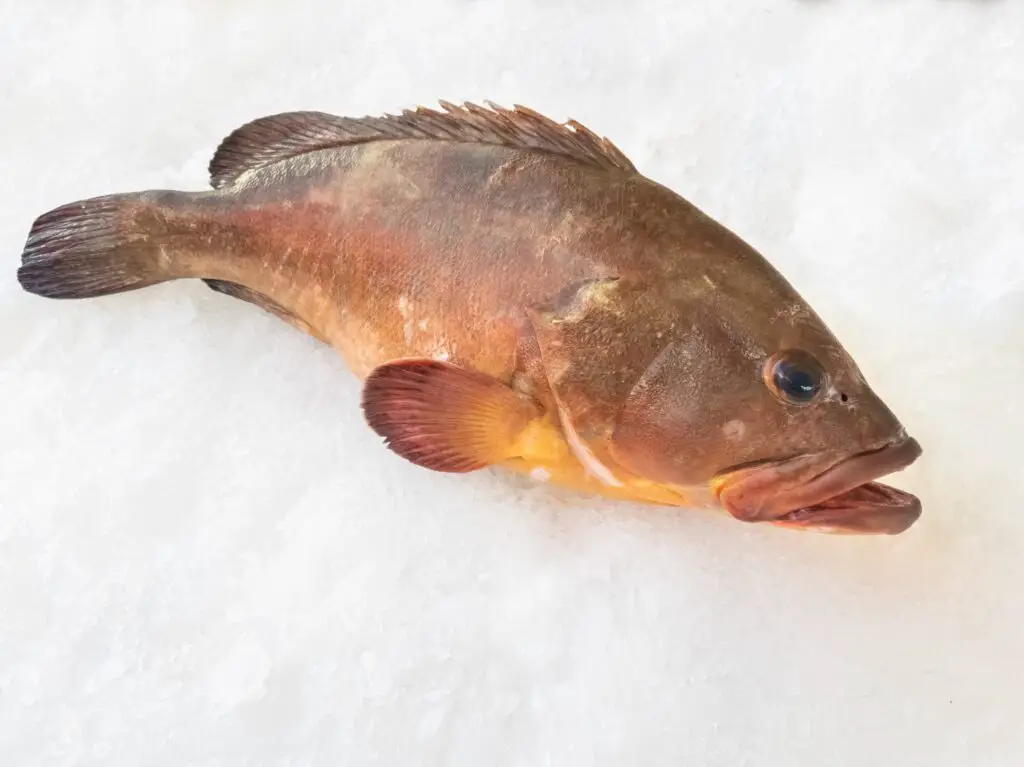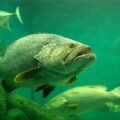The Wreckfish is a typical tropical marine fish. It lives in areas with coral reefs and feeds on the sediment there. The Wreckfish is chubbier and has a broader snout than the Grouper. The Grouper, like the Wreckfish, has two dorsal fins and an anal fin, although its fins are less prominent. These fish can grow 7 feet long and weigh up to 100 kilograms. Grouper may grow to an impressive 8 feet in length and weigh 400 pounds.
A trip to a local restaurant is more likely than reading about local gamefish before venturing offshore in Georgia, South Carolina, or North Carolina, where wreckfish, also known as stone bass, are common. These fish are a well-kept secret but require some unique gear. Since the stone bass is typically found in deep water, it is tough to be mistaken for any other type of fish. A wreckfish’s colossal mouth and head complement its black or brown fins, silvery sides, and grey back.
An adult stone bass can easily weigh over a pound. They can weigh more than 200 lbs but typically hover between 30 and 70 kilos. A Wreckfish is a type of fish found in the ocean. It is a bottom-dwelling fish that can live in various habitats.
Wreckfish are known for their powerful jaws and sharp teeth. They can extract food from tight spaces on the ocean floor, where other fish cannot go. Wreckfish also have a strong sense of smell, which helps them locate food sources.
Compared to Grouper, Wreckfish is generally more accessible to find. They typically inhabit coral reefs, making them susceptible to being caught with a hook and line. On the other hand, Grouper inhabits deeper waters and can be found in saltwater and freshwater habitats.
Atlantic Wreckfish: Essential Facts
Most wreckfish species inhabit waters between 140 and 3,300 feet deep. They spend the first several years of their lives near floating trash on the water’s surface. Wreckfish are primarily found in deep reefs and rocky areas where they can find food and refuge as adults. Overhangs and caverns are common locations for them.
Atop the Charleston Bump’s ever-changing food web, wreckfish stand out as formidable top-tier predators. Because the Gulf Stream is redirected offshore by the Charleston Bump, nutrient-rich water rises to the surface, encouraging the growth and production of phytoplankton and the zooplankton that feed on them.
Wreckfish have no known natural predators. Wreckfish are nocturnal feeders that retreat to deeper waters during the day to rest and digest their food away from the prying eyes of predators and the warmer daylight. Wreckfish hide during the night in caves and beneath overhangs on the bumps, emerging during the day to prey on migrating fish and squid.

Wreckfish vs. Grouper
-
- Wreckfish can be as big as grouper.
-
- Wreckfish is more aggressive.
-
- Wreckfish have a stronger jaw.
-
- Wreckfish have a higher tolerance for salt water.
Habitat and Distribution of Wreckfish and Grouper
There are gaps in the Atlantic wreckfish’s global distribution. Its range extends from the Mediterranean to the Micronesian Islands and Tristan da Cunha in the eastern Atlantic Ocean. It can be found in the southwestern Pacific Ocean, close to New Zealand, and in the western Indian Ocean, near Île Saint-Paul and Île Amsterdam. From Newfoundland to Argentina, it populates the west Atlantic. From Tasmania in the south to Fraser Island in the north, it is present in the waters of Australia.
Adult Atlantic wreckfish live in caves, stony substrates, natural reefs, and shipwrecks. Adults meet in summer to nurture the young. Juveniles form shoals to escape being eaten by bigger fish. When they reach 50 to 75 centimetres, they seek area alone. Atlantic wreckfish can live 90 years. Crustaceans, octopuses, and bottom-dwelling fish are also fair game. One ROV camera captured a large group of small sharks dining on a dead swordfish, with one shark being eaten whole by a wreckfish. They’re opportunistic, then. Large bony fish and sharks may threaten juveniles but not adults.
Grouper lives in the Caribbean, Gulf of Mexico, and the Atlantic Ocean between Florida and Brazil. The eastern Pacific, from the Gulf of California in Mexico to Peru, and the eastern Atlantic, from Senegal to the Congo, both have it.
Wreckfish is a bit more aggressive than grouper, but they both have a great appetite and can take down large fish. They are both famous for sport fishing, so it comes down to what you are looking for in a fish. Groupers are some of the best eating fish and can be found in almost any coastal region.
There are many similarities and differences between Wreckfish and Grouper. Let’s take a closer look:
-
- Wreckfish and Grouper can be used to make various fish dishes in a wide range of conditions.
-
- Both Wreckfish and Grouper offer great potential for anglers targeting bottom-dwelling species.
-
- Wreckfish and Grouper are popular among tournament anglers as they provide a high reward for skilled fishing.
-
- Wreckfish and Grouper have strong fighting abilities, making them suitable for catching large fish.
How does the Atlantic Wreckfish differ from other bass-like species?
The Atlantic Wreckfish (Etmopterus acuminatus) is a bass-like fish found in the Atlantic Ocean. It differs from other bass-like species due to its elongated body and large, scaly head. It is a bass-like fish that measures up to 7 feet long and weighs 600 pounds.
The Atlantic Wreckfish is an aggressive fish that feeds on small fish, crustaceans, and molluscs. It is also known for its ability to swim and change direction quickly. Unlike the grouper, the wreckfish has no close relatives. While it may share some similarities with the grouper, including a preference for living on the seafloor, it is a separate species.
Wreckfish vs. Grouper
The main similarity between the Wreckfish and the Grouper is their feeding habits. This is because the wreckfish’s diet is so varied. The Grouper mainly feeds on bottom-dwelling organisms it can reach with its snouts, such as small fish and crustaceans. The fish’s nutrition greatly influences the flavour and texture of fish fillets. Animals in this category include crabs, squid, and the fish known as cuttlefish.
Another essential difference between the two species is their body shape. The Grouper has a torpedo-like body that makes it swim slowly through the water. On the other hand, the Wreckfish has a round body shape and is faster moving. Both species are known for their strong bites, but the Wreckfish’s teeth are smaller and sharper than the Grouper’s.
Reproduction of Wreckfish and Grouper
Wreckfish spawn many times in the Charleston Bump area between January and mid-April. When the eggs hatch, the larvae swim across the Atlantic Ocean to the coast of Europe, and eventually, the adults make their way back to the southeastern coast of the United States.
In the South Atlantic, wreckfish are enormous carnivores that hide throughout the day in caves and under overhangs on Charleston Bump, emerging only to feast on migrating fish and squid. There are no known predators of this species. On the other hand, the spawning season is when young groupers reach sexual maturity and can lay eggs. Once they have lived as women for an extended time, they experience a process termed “sex reversal,” in which they take on more traditionally male features.
Conclusion
There are a lot of fish comparisons out there, but which is the best? Wreckfish vs Grouper is one of the more common ones, and while they both have their fans, it’s essential to understand what each one can do well before deciding which one to use in your following recipe.
First and foremost, Wreckfish is known for its tenderness and flavour when cooked. They also hold their texture well, so they don’t turn into mush when cooked through. Grouper, on the other hand, has slightly richer flavour profiles and a firmer texture—both of which make them great for grilling or pan-frying. Overall, we think both are great and have unique characteristics and tastes.











